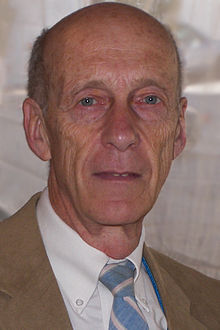Simon LeVay (born August 28, 1943)

Simon LeVay (born 28 August 1943) is a British-American neuroscientist. He is renowned for his studies about brain structures and sexual orientation.
LeVay was born on 28 August 1943 in Oxford, England. He is openly gay.
LeVay held positions in neurobiology at the Harvard Medical School from 1974 to 1984. He then worked at the Salk Institute for Biological Studies from 1984 to 1993 while holding an Associate Professorship in Biology at the University of California, San Diego. Much of his early work focused on visual cortex in animals, especially cats. In 2003 he was a lecturer and the Director of Human Sexuality Studies at Stanford University.
In 1991, LeVay published "A difference in hypothalamic structure between heterosexual and homosexual men" in Science. This article reported a difference in average size between the third Interstitial Nucleus of the Anterior Hypothalamus (INAH3) in the brains of heterosexual men and homosexual men: INAH3 was more than twice as large in heterosexual men as in homosexual men. The INAH3 size of homosexual men was the same as that of women. LeVay wrote that "This finding indicates that INAH is dimorphic with sexual orientation, at least in men, and suggests that sexual orientation has a biological substrate." LeVay added, "The existence of 'exceptions' in the present sample (that is, presumed heterosexual men with small INAH 3 nuclei, and homosexual men with large ones), hints at the possibility that sexual orientation, although an important variable, may not be the sole determinant of INAH 3 size. It is also possible, however, that these exceptions are due to technical shortcomings or to misassignment of subjects to their subject groups."
LeVay's finding was widely reported in the media. LeVay openly related his research to his own homosexuality and to his mourning over his lover's death from AIDS. LeVay cautioned against misinterpreting his findings in a 1994 interview: "It’s important to stress what I didn’t find. I did not prove that homosexuality is genetic, or find a genetic cause for being gay. I didn't show that gay men are born that way, the most common mistake people make in interpreting my work. Nor did I locate a gay center in the brain. The INAH3 is less likely to be the sole gay nucleus of the brain than a part of a chain of nuclei engaged in men and women's sexual behavior." Some critics of LeVay questioned the accuracy and appropriateness of his measurements, observing that the structures are difficult to see in tissue slices and that he measured in volume rather than cell count. Nancy Ordover writes that LeVay has been criticized for "his small sample size and for compiling inadequate sexual histories."
Source: https://en.wikipedia.org/wiki/Simon_LeVay
Further Readings:

Gay, Straight, and the Reason Why: The Science of Sexual Orientation by Simon LeVay
Paperback: 432 pages
Publisher: Oxford University Press; Reprint edition (September 1, 2012)
Language: English
ISBN-10: 0199931585
ISBN-13: 978-0199931583
Amazon: Gay, Straight, and the Reason Why: The Science of Sexual Orientation
What causes a child to grow up gay or straight? In this book, neuroscientist Simon LeVay summarizes a wealth of scientific evidence that points to one inescapable conclusion: Sexual orientation results primarily from an interaction between genes, sex hormones, and the cells of the developing body and brain.
LeVay helped create this field in 1991 with a much-publicized study in Science, where he reported on a difference in the brain structure between gay and straight men. Since then, an entire scientific discipline has sprung up around the quest for a biological explanation of sexual orientation. In this book, LeVay provides a clear explanation of where the science stands today, taking the reader on a whirlwind tour of laboratories that specialize in genetics, endocrinology, neuroscience, cognitive psychology, evolutionary psychology, and family demographics. He describes, for instance, how researchers have manipulated the sex hormone levels of animals during development, causing them to mate preferentially with animals of their own gender. LeVay also reports on the prevalence of homosexual behavior among wild animals, ranging from Graylag geese to the Bonobo chimpanzee.
Although many details remain unresolved, the general conclusion is quite clear: A person's sexual orientation arises in large part from biological processes that are already underway before birth. LeVay also makes it clear that these lines of research have a lot of potential because--far from seeking to discover "what went wrong" in the lives of gay people, attempting to develop "cures" for homosexuality, or returning to traditional explanations that center on parent-child relationships, various forms of "training," or early sexual experiences--our modern scientists are increasingly seeing sexual variety as something to be valued, celebrated, and welcomed into society.
More Spotlights at my website: elisarolle.com, My Lists/Gay Novels
This journal is friends only. This entry was originally posted at http://reviews-and-ramblings.dreamwidth.org/4685933.html. If you are not friends on this journal, Please comment there using OpenID.